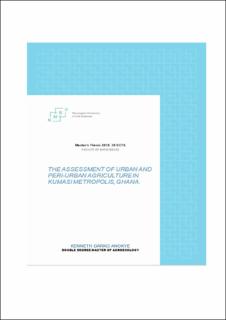| dc.description.abstract | Presently, half of the world’s population lives in urban areas and the rate of urban development is expected to remain the same in this 21st century, with most of the growth taking place in the developing world. The urbanization of African cities, like Kumasi, Ghana has brought in its wake a lot of challenges such as urban sprawl, slum proliferation, transportation challenges, growing informalisation, destruction of ecologically sensitive areas, indescribable scenes of filth and gradual extinction of urban greenery.The ability of Urban and Peri-Urban Agriculture (UPA) to sustainably contribute to livelihoods is becoming increasingly problematic as the combined effects of urban planning, insecure tenancy and diminishing land and its related stresses, create significant challenges for the farmer's livelihood in Kumasi Metropolis. In spite of its important functions, the value and nature of urban farming have not been given enough attention by researchers. This study fills this gap by focusing on identifying the characteristics and the state of incorporating urban agriculture in Kumasi.Also evaluated is how urban and peri-urban agriculture supports productivity and the possibility of its integration into urban development in Kumasi.Furthermore,the study analyzes the prospects of urban planning strategies and the actual role of land planners in the promotion and development of urban agriculture. Lastly, the existing structures that support and could reinforce urban agriculture in Kumasi is reassessed. This research is based on the mixed methods approach, by using three case study communities in the Kumasi Metropolis in Ghana. Using semi-structured interviews, qualitative data were collected from institutional representatives of urban planning-related institutions in May - June, 2019. The data were subjected to descriptive statistical analysis using the Statistical Product and Service Solutions (SPSS) software package, version 10. Tables, figures, graphs, and percentages were used in the case of the qualitative technique with the help of the SPSS software package. The qualitative analysis was also involved in the descriptive presentation and it was used to analyze data obtained from the institutions. Qualitative data were collected during the same period from 64 urban farmers and (11) stakeholders from representatives institutions across the three selected Areas ;Afrancho in the Afigya Kwabre South District,Mamponteng in the Afigya Kwabre East and Adako-Jachie in the Ejisu Municipal.The findings indicated that urban farmers across the three selected areas, mostly produce fruits and vegetables. More so, urban farmers produce urban food for consumption, and not primarily for the market. It became evident that urban agriculture is important because it provides employment and financial resources for some urban dwellers. UPA also beautifies the environment, conserves biodiversity and also provides relatively fresh and safer produce compared to stored foods. Notwithstanding, limited access to land and tenure, high cost of inputs (fertilizer, pesticides, farm implements, seeds, etc.), pests and disease threats to crops, inadequate access to credit and market for produce are pertinent challenges that urban farmers encounter.It was very evident from the study that integration of urban agriculture cannot be accomplished by the local Assemblies alone, but rather all stakeholders are needed on board. In order to realize its full potential, urban agriculture needs to be integrated into urban development and that there should be the availability of sufficient land which must be secured for an extended period of time. Also, there should be enough funds, technical advisors, and planting materials to support UPA.Importantly, in order for urban planners to successfully incorporate urban agriculture into development, there is a need to advise landowners, especially chiefs are custodians of the majority the lands in Kumasi to permanently designate more dry areas for agricultural activities and not only swampy lands that are not suitable for development. | en_US |

